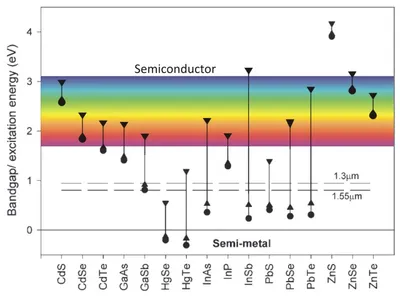Colloidal QDs applications
Due to the unique properties of colloidal QDs, they have gained a great deal of interest recently. They have been already utilized in optoelectronic devices fabrication. For instance, CdSe/ZnS shell QD with an organic monolayer was employed in light emitting diodes (LED) fabrication. Band-gap sensitivity to the particle diameter modification make their emission covers a wide range of the electromagnetic spectrum. Figure (1) shows the tunability limits of a range of semiconductors. Therefore, those emitted in the near IR region of the electromagnetic spectrum can be used as a biological fluorescent tags or for deep tissue imaging, as this is the region were the absorption / scattering by blood, water and hemoglobin are minima. While other are promising for optical switches at the telecommunication window, QD lasing, photovoltaic and thin film solar cells.

Figure (1) Band gap tunning limits for a range of semiconductors. Bulk band gaps are represented
as black circles. The up-word triangle represents particle diameter of 10nm, while the down-word
triangle represents particle diameter of 3nm. The visible band and the telecommunication window
lines at 1.3 and 1.55 micron are highlighted. reproduced after [1].
References:
- Rogach A. L., Eychmuller A., Hickey S. G., and Kershaw S. V., Infrared-Emitting Colloidal Nanocrystals: Synthesis, Assembly, Spectroscopy, and Applications , Small, 3,536, (2007).
- Sargent E. H., Infrared Quantum Dots, Advanced Materials., 17, 515, (2005)
